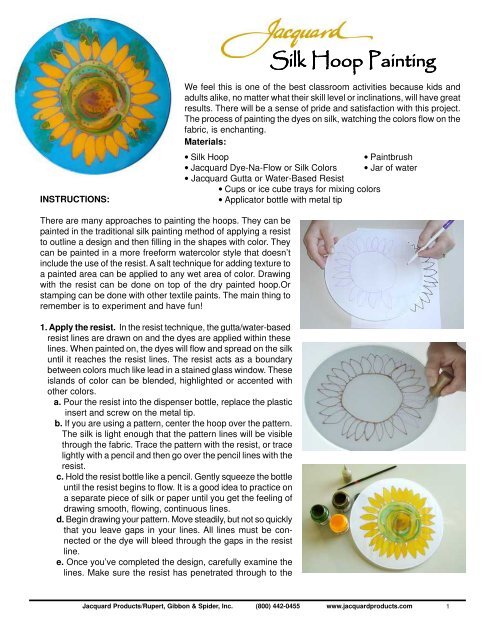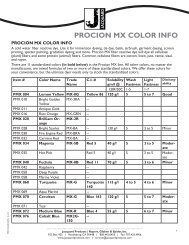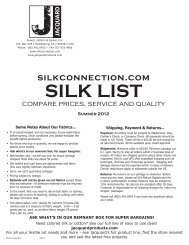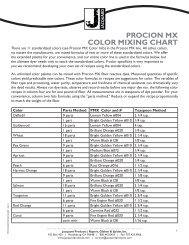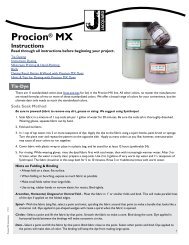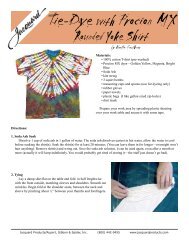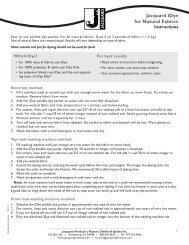Silk Hoop Painting dl.p65 - Jacquard Products
Silk Hoop Painting dl.p65 - Jacquard Products
Silk Hoop Painting dl.p65 - Jacquard Products
- No tags were found...
You also want an ePaper? Increase the reach of your titles
YUMPU automatically turns print PDFs into web optimized ePapers that Google loves.
<strong>Silk</strong> <strong>Hoop</strong> <strong>Painting</strong><br />
INSTRUCTIONS:<br />
We feel this is one of the best classroom activities because kids and<br />
adults alike, no matter what their skill level or inclinations, will have great<br />
results. There will be a sense of pride and satisfaction with this project.<br />
The process of painting the dyes on silk, watching the colors flow on the<br />
fabric, is enchanting.<br />
Materials:<br />
• <strong>Silk</strong> <strong>Hoop</strong><br />
• Paintbrush<br />
• <strong>Jacquard</strong> Dye-Na-Flow or <strong>Silk</strong> Colors • Jar of water<br />
• <strong>Jacquard</strong> Gutta or Water-Based Resist<br />
• Cups or ice cube trays for mixing colors<br />
• Applicator bottle with metal tip<br />
There are many approaches to painting the hoops. They can be<br />
painted in the traditional silk painting method of applying a resist<br />
to outline a design and then filling in the shapes with color. They<br />
can be painted in a more freeform watercolor style that doesn’t<br />
include the use of the resist. A salt technique for adding texture to<br />
a painted area can be applied to any wet area of color. Drawing<br />
with the resist can be done on top of the dry painted hoop.Or<br />
stamping can be done with other textile paints. The main thing to<br />
remember is to experiment and have fun!<br />
1. Apply the resist. In the resist technique, the gutta/water-based<br />
resist lines are drawn on and the dyes are applied within these<br />
lines. When painted on, the dyes will flow and spread on the silk<br />
until it reaches the resist lines. The resist acts as a boundary<br />
between colors much like lead in a stained glass window. These<br />
islands of color can be blended, highlighted or accented with<br />
other colors.<br />
a. Pour the resist into the dispenser bottle, replace the plastic<br />
insert and screw on the metal tip.<br />
b. If you are using a pattern, center the hoop over the pattern.<br />
The silk is light enough that the pattern lines will be visible<br />
through the fabric. Trace the pattern with the resist, or trace<br />
lightly with a pencil and then go over the pencil lines with the<br />
resist.<br />
c. Hold the resist bottle like a pencil. Gently squeeze the bottle<br />
until the resist begins to flow. It is a good idea to practice on<br />
a separate piece of silk or paper until you get the feeling of<br />
drawing smooth, flowing, continuous lines.<br />
d. Begin drawing your pattern. Move steadily, but not so quickly<br />
that you leave gaps in your lines. All lines must be connected<br />
or the dye will bleed through the gaps in the resist<br />
line.<br />
e. Once you’ve completed the design, carefully examine the<br />
lines. Make sure the resist has penetrated through to the<br />
<strong>Jacquard</strong> <strong>Products</strong>/Rupert, Gibbon & Spider, Inc. (800) 442-0455 www.jacquardproducts.com 1
ack. Go back and fill in any gaps. Let the resist dry completely, usually 30 minutes. Use a hair dryer<br />
to speed drying time.<br />
2. Mix and apply the dye. Use Dye-na-Flow or <strong>Silk</strong> Colors.<br />
a. Use straight from bottle or use an ice cube tray to mix colors.<br />
b. Dip your brush gently into a color. Touch the brush to the fabric about 1/2” from the resist line. The<br />
dye will migrate the rest of the way. Paint all areas inside the gutta lines. For large areas, work<br />
quickly painting the color from corner to corner. Always work wet to wet. Never go over a dry area.<br />
c. For the silk hoop paintings, setting the dyes is not necessary.<br />
Salt Technique: A beautiful starburst affect can be achieved by sprinkling salt over the fabric while still<br />
wet. Different size salt granules can be used, from table salt to rock salt, to create different size starbursts.<br />
The larger the granule, the larger the effect. The salt should be applied immediately while the fabric is<br />
still very wet. The salt crystals will begin to soak up the dye as it dries.<br />
<strong>Jacquard</strong> <strong>Products</strong>/Rupert, Gibbon & Spider, Inc. (800) 442-0455 www.jacquardproducts.com 2


